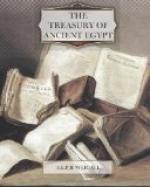The temperature was very great in the tomb, and the perspiration streamed down our faces as we stood contemplating the devastation. Now the electric lamps would flash upon the gods supporting the ransacked sarcophagus, lighting for a moment their grotesque forms; now the attention would concentrate upon some wooden figure of a hippopotamus-god or cow-headed deity; and now the light would bring into prominence the great overthrown statue of the king. There is something peculiarly sensational in the examining of a tomb which has not been entered for such thousands of years, but it must be left to the imaginative reader to infuse a touch of that feeling of the dramatic into these words. It would be hopeless to attempt to put into writing those impressions which go to make the entering of a great Egyptian sepulchre so thrilling an experience: one cannot describe the silence, the echoing steps, the dark shadows, the hot, breathless air; nor tell of the sense of vast Time the penetrating of it which stirs one so deeply.
The air was too bad to permit of our remaining long so deep in the bowels of the earth; and we presently made our way through halls and corridors back to the upper world, scrambling and crashing over the debris, and squeezing ourselves through the rabbit-hole by which we had entered. As we passed out of this hot, dark tomb into the brilliant sunlight and the bracing north wind, the gloomy wreck of the place was brought before the imagination with renewed force. The scattered bones, the broken statues, the dead flowers, grouped themselves in the mind into a picture of utter decay. In some of the tombs which have been opened the freshness of the objects has caused one to exclaim at the inaction of the years; but here, where vivid and well-preserved wall-paintings looked down on a jumbled collection of smashed fragments of wood and bones, one felt how hardly the Powers deal with the dead. How far away seemed the great fight between Amon and Aton; how futile the task which Horemheb accomplished so gloriously! It was all over and forgotten, and one asked oneself what it mattered whether the way was difficult or the battle slow to win. In the fourth year of the reign of Horemheb a certain harper named Neferhotep partly composed a song which was peculiarly appropriate to the tune which ran in one’s head at the opening of the tomb of this Pharaoh whom the harper served—
“(1.) Behold the dwellings of the dead. Their walls fall down; their place is no more: they are as though they had never existed. (2.) That which hath come into being must pass away again. The young men and maidens go to their places; the sun riseth at dawn, and setteth again in the hills of the west. Men beget and women conceive. The children, too, go to the places which are appointed for them. O, then, be happy! Come, scents and perfumes are set before thee: mahu-flowers and lilies for the arms and neck of thy beloved.




